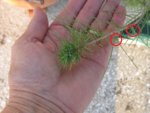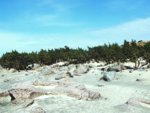my nellie
Masterpiece
In another thread the number of flushes of new growth has arisen.
@DirkvanDreven had asked me to confirm if possible that Pinus halepensis in Cyprus has three pushes of shoots per year.
I do love trees in nature and I admire their stature, I can recognize some of them, I can tell their figure/shape BUT I am not the kind of person who attends closely their habits and growth patterns...
I was always thinking that successive flush of new shoots is induced by decandling, like @Brian Van Fleet posted in said thread : "On their own, all pines will produce a single flush and sit lazy all summer. Some can be forced to produce a second."
However, after Dirk's observation I started searching an old article of Ofer Grunwald about P. halepensis in which he declared Aleppo Pine to have three + one more flushes (in favourable conditions) of growth.
Then I searched for a while on the internet and I thought I would share two pieces of what I have come up with in order for others knowledgeable members to hopefully chime in and offer their knowledge.
So, here it is and thank you for reading
1) THE GROWING TREE by Brayton F. Wilson
On page #78
If a lateral shoot meristem forms a bud immediately, the bud is inhibited from growing by other parts of the plant. If the leaves are removed, or if the stem is injured above the bud, although the lateral bud is inhibited, it will grow out to form a shoot. Buds on vigorous trees may overcome the inhibition and grow out as a result of favorable environmental conditions.
There are three different types of such growth. There may be a multiple flush where the terminal and laterals grow out one of more times during a growing season. Fast-growing southern pines have several flushes of growth, often four to six in a year.
At each flush the terminal elongates, a new whorl of lateral branches is formed, and new buds are formed. This sequence of flushes makes it difficult for people who are used to northern pines, which form only one whorl of branches each year, to determine the age of a tree by simply counting the number of annual whorls of branches. It still may be possible to determine the age of southern pines by counting whorls because the first flush each year usually produces the greatest terminal elongation and successive flushes elongate less so that there is an annual repeating pattern of long to short flushes.
Fast-growing individuals of many temperate species that do not have multiple flushes will briefly resume growth after making buds if the early summer weather is warm and moist. This extra growth is usually much less than the previous elongation in the spring.
Often just the terminal grows (lammas growth) or just the laterals grow (prolepsis). Lammas growth looks odd because it is so much less than a normal year’s growth, but it does not drastically affect the form of the tree. Prolepsis is particularly common in fast-growing pines. The lateral buds grow out in the same year they are formed, but the terminal does not. In following years these precocious laterals frequently dominate the terminal shoot and several of the lateral branches may become replacement terminals. The result is a much-forked main stem that closely resembles the forking resulting from injury to the main stem. Such injuries are particularly common from the white pine weevil in the eastern U.S. Usually the much-forked form of “pasture pines” is attributed to the effect of the weevil, but in young, fast growing trees the results of prolepsis are nearly identical and are most likely to occur in open fields where growth is rapid. Prolepsis can be distinguished from weevil damage because there is no dead terminal and because there is a small whorl of buds which grow out again in the same year, are different from apical dominance and control, yet they share some features.
@DirkvanDreven had asked me to confirm if possible that Pinus halepensis in Cyprus has three pushes of shoots per year.
I do love trees in nature and I admire their stature, I can recognize some of them, I can tell their figure/shape BUT I am not the kind of person who attends closely their habits and growth patterns...
I was always thinking that successive flush of new shoots is induced by decandling, like @Brian Van Fleet posted in said thread : "On their own, all pines will produce a single flush and sit lazy all summer. Some can be forced to produce a second."
However, after Dirk's observation I started searching an old article of Ofer Grunwald about P. halepensis in which he declared Aleppo Pine to have three + one more flushes (in favourable conditions) of growth.
Then I searched for a while on the internet and I thought I would share two pieces of what I have come up with in order for others knowledgeable members to hopefully chime in and offer their knowledge.
So, here it is and thank you for reading
1) THE GROWING TREE by Brayton F. Wilson
On page #78
If a lateral shoot meristem forms a bud immediately, the bud is inhibited from growing by other parts of the plant. If the leaves are removed, or if the stem is injured above the bud, although the lateral bud is inhibited, it will grow out to form a shoot. Buds on vigorous trees may overcome the inhibition and grow out as a result of favorable environmental conditions.
There are three different types of such growth. There may be a multiple flush where the terminal and laterals grow out one of more times during a growing season. Fast-growing southern pines have several flushes of growth, often four to six in a year.
At each flush the terminal elongates, a new whorl of lateral branches is formed, and new buds are formed. This sequence of flushes makes it difficult for people who are used to northern pines, which form only one whorl of branches each year, to determine the age of a tree by simply counting the number of annual whorls of branches. It still may be possible to determine the age of southern pines by counting whorls because the first flush each year usually produces the greatest terminal elongation and successive flushes elongate less so that there is an annual repeating pattern of long to short flushes.
Fast-growing individuals of many temperate species that do not have multiple flushes will briefly resume growth after making buds if the early summer weather is warm and moist. This extra growth is usually much less than the previous elongation in the spring.
Often just the terminal grows (lammas growth) or just the laterals grow (prolepsis). Lammas growth looks odd because it is so much less than a normal year’s growth, but it does not drastically affect the form of the tree. Prolepsis is particularly common in fast-growing pines. The lateral buds grow out in the same year they are formed, but the terminal does not. In following years these precocious laterals frequently dominate the terminal shoot and several of the lateral branches may become replacement terminals. The result is a much-forked main stem that closely resembles the forking resulting from injury to the main stem. Such injuries are particularly common from the white pine weevil in the eastern U.S. Usually the much-forked form of “pasture pines” is attributed to the effect of the weevil, but in young, fast growing trees the results of prolepsis are nearly identical and are most likely to occur in open fields where growth is rapid. Prolepsis can be distinguished from weevil damage because there is no dead terminal and because there is a small whorl of buds which grow out again in the same year, are different from apical dominance and control, yet they share some features.
Last edited:



















